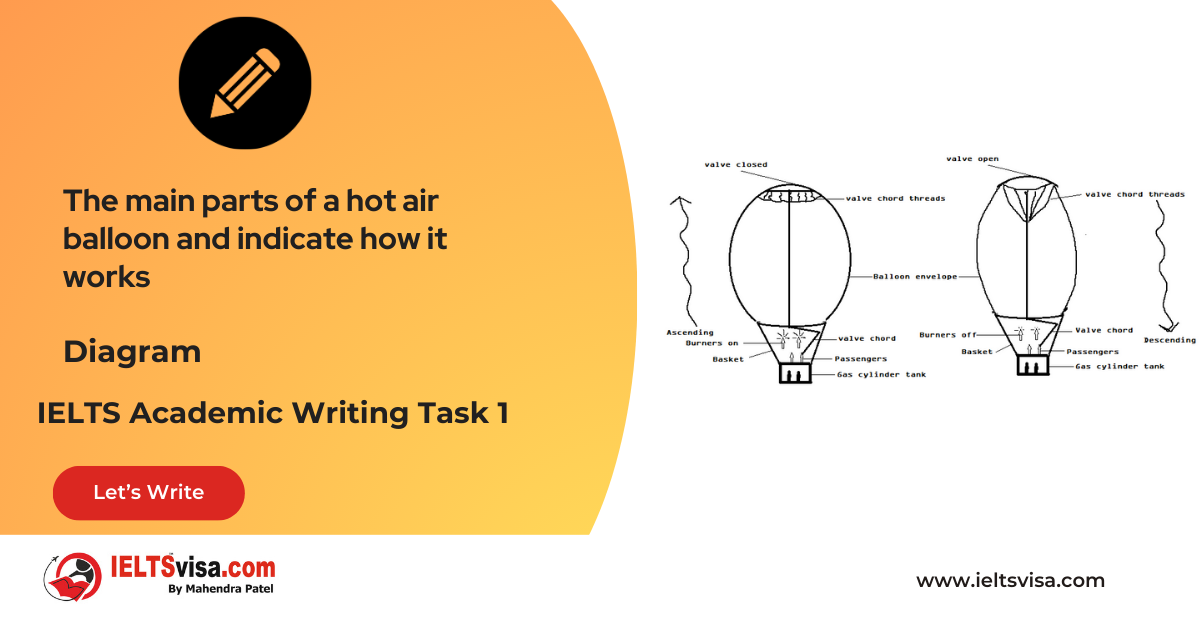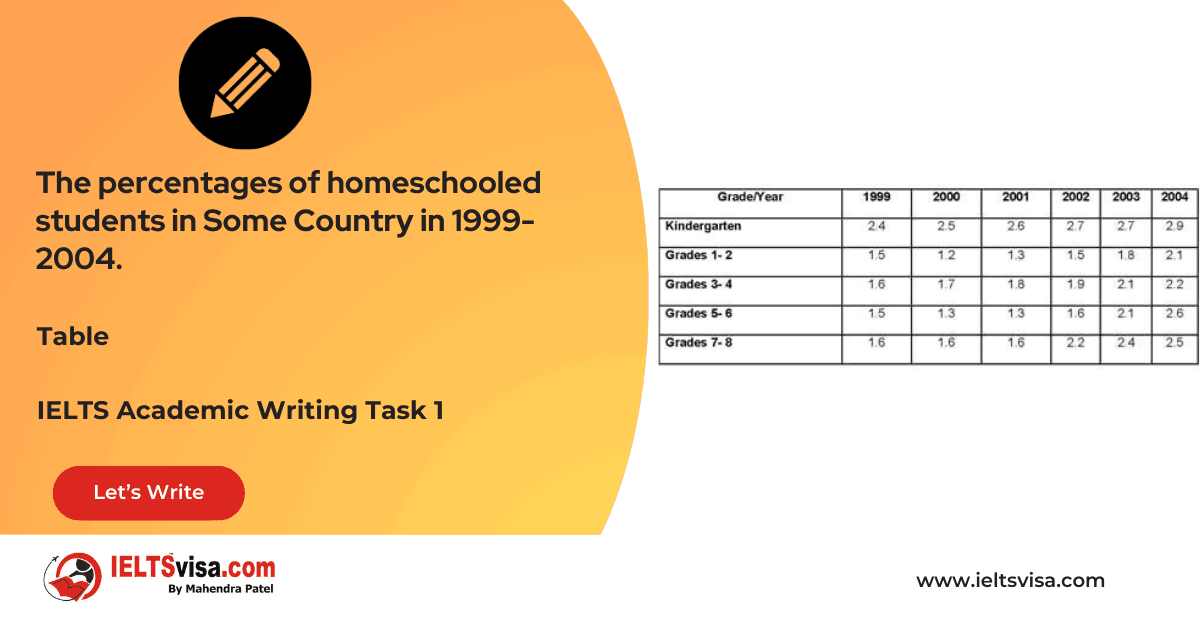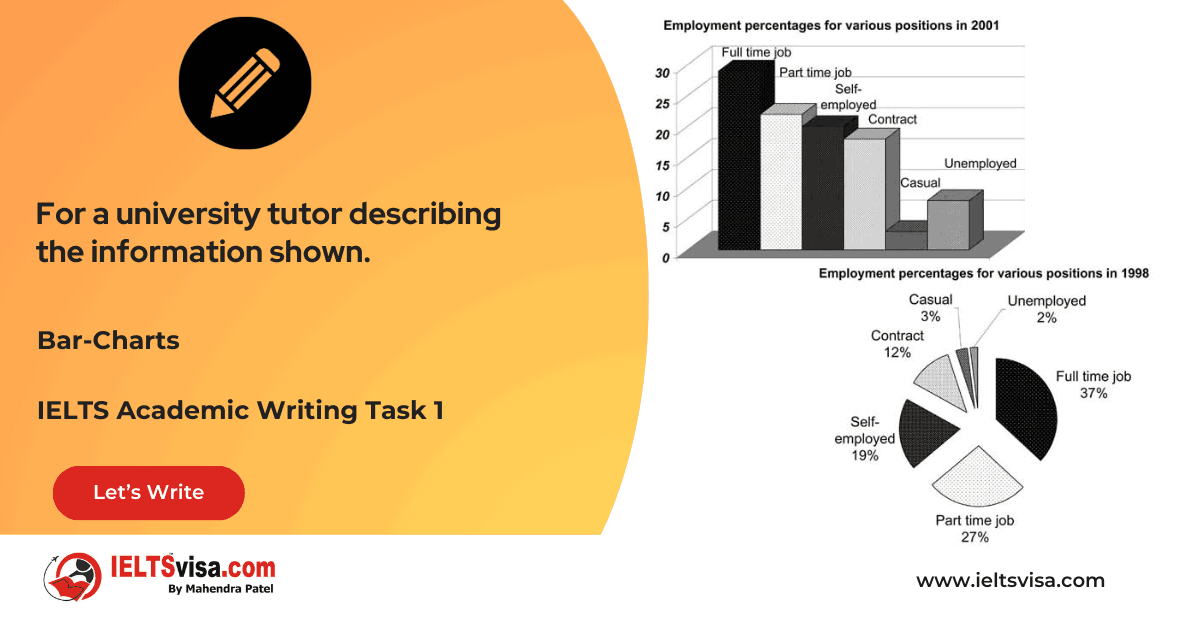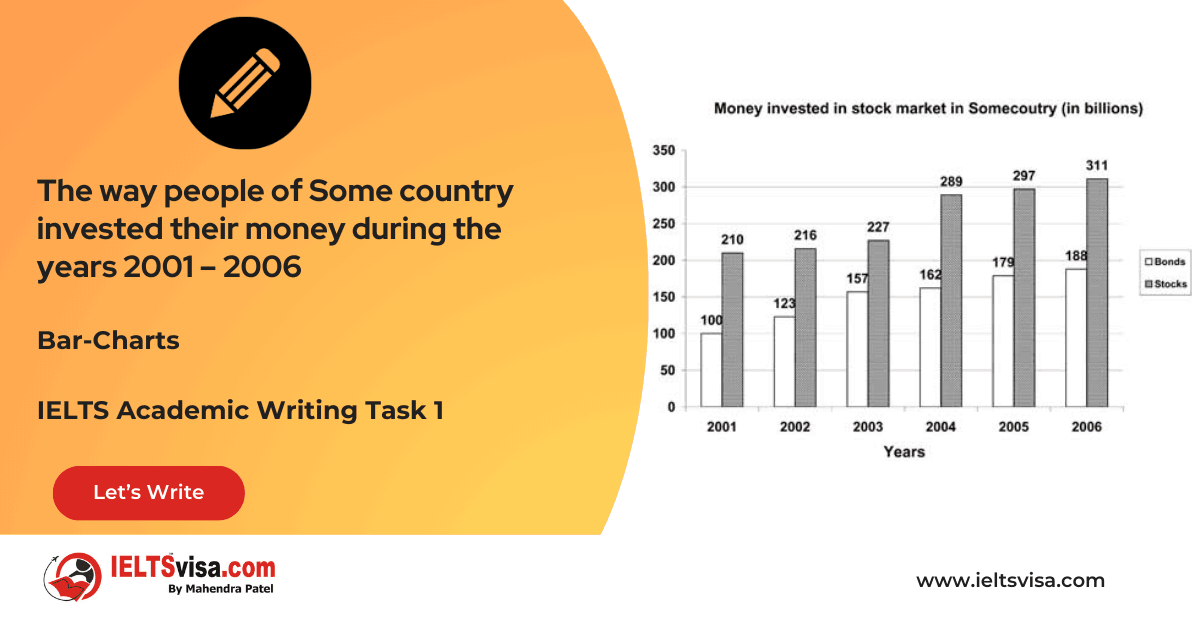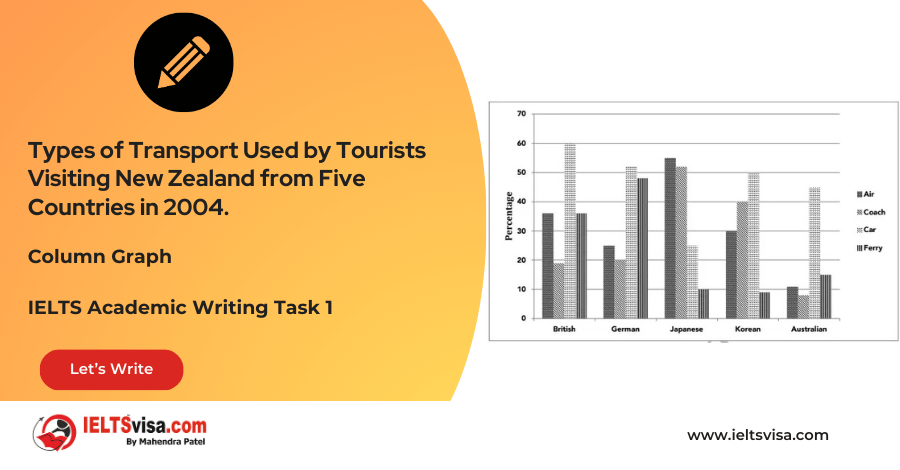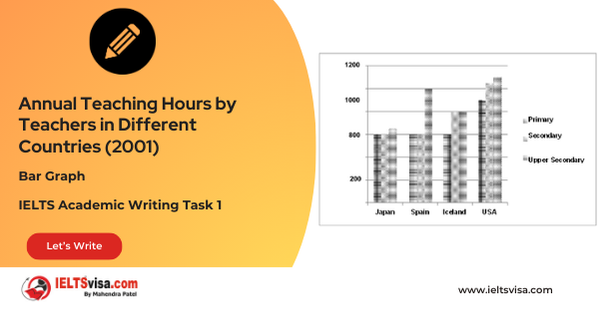Percentage of Young People Enrolled in Universities in 2000 and 2007
IELTS Academic Writing Task 1 - Column Graph
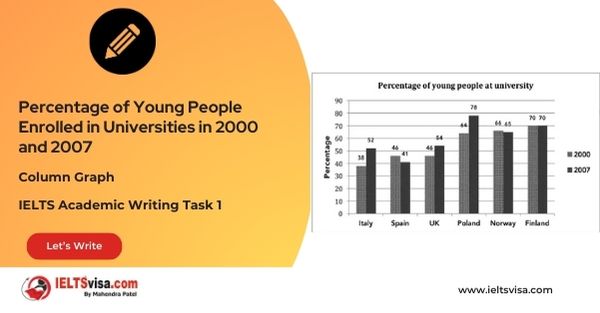
IELTS Writing Task 1 Question
The chart below shows the percentage of young people at a university in 2000 and 2007. Summarise the information by selecting and reporting the main features and make comparisons where relevant.

Common questions for the university student percentage chart
1. Graph Type: Column graph.
2. Title: Percentage of Young People Enrolled in Universities in 2000 and 2007.
3. What are the units of measurement?: Percentage of students.
4. Who: Young people in six countries.
5. When: Years 2000 and 2007.
6. Where: Six countries (Finland, Poland, Norway, Spain, UK, and Italy).
7. Topic: The chart compares the percentage of university students in different countries in 2000 and 2007.
Comparison Showing and Trends
Comparison 1: Finland
- Finland had the highest percentage of university students in 2000 at 70%, but there was no change by 2007.
Comparison 2: Italy and Poland
- Italy and Poland showed the most significant increases, with both countries seeing a rise of 14% in university enrollment.
Comparison 3: Spain and UK
-
- In contrast, Spain saw a decrease of 5%, while the UK had a moderate increase of 8%, from 46% in 2000 to 54% in 2007.
Sample Answer
The graph given illustrates the percentage of young people studying at universities in six countries in 2000 and 2007. It is clear that the percentages fluctuated across countries over the seven-year period.
In 2000, Finland had the highest proportion of university students at 70%, followed by Poland and Norway, with 64% and 66% respectively. Spain and the UK had lower enrollment rates, with 46% of young people attending university. Italy had the most minor proportion at just 38%.
By 2007, Finland’s percentage remained unchanged, while Norway and Spain saw a slight decrease of 1% and 5% respectively. The most significant increase was observed in Italy and Poland, with both countries seeing a 14% rise in the percentage of students attending university. The UK showed a moderate increase, with the proportion of students rising by 8%.
Overall, Poland had the highest percentage of students at university in 2007, while Spain had the lowest.
Top 27 Vocabulary
Vocabulary |
Meaning |
Synonyms |
Examples |
Vocabulary Type |
|---|---|---|---|---|
|
Illustrates |
To explain or make something clear |
Demonstrates, shows |
“The graph illustrates the percentage of students in six countries.” |
Verb |
|
Fluctuated |
To vary or change frequently |
Shifted, varied |
“The percentage of students fluctuated across countries over the years.” |
Verb |
|
Proportion |
A part or share of the whole |
Percentage, ratio |
“Finland had the highest proportion of students in 2000.” |
Noun |
|
Observed |
To notice or see something |
Seen, noticed |
“The most significant increase was observed in Italy and Poland.” |
Verb |
|
Slight |
Small in degree or amount |
Minor, small |
“Norway and Spain saw a slight decrease in university enrollment.” |
Adjective |
|
Increase |
A rise in number, quantity, or degree |
Growth, surge |
“The most significant increase was in Italy and Poland.” |
Noun |
|
Decrease |
A reduction in amount or number |
Reduction, drop |
“Spain experienced a decrease in the percentage of students attending.” |
Noun |
|
Enrollment |
The process of registering or being admitted to a program |
Admission, registration |
“University enrollment increased significantly in both Italy and Poland.” |
Noun |
|
Moderate |
Average in degree, not extreme |
Fair, modest |
“The UK showed a moderate increase in university enrollment.” |
Adjective |
|
Maximum |
The greatest possible amount or degree |
Highest, utmost |
“Italy and Poland saw the maximum increase in university enrollment.” |
Noun |
|
Rate |
A measure or amount of something over a period of time |
Ratio, proportion |
“The enrollment rate in Finland remained the same.” |
Noun |
|
Remarkable |
Worth noticing, often due to its significance |
Extraordinary, striking |
“The increase in Italy’s university enrollment was remarkable.” |
Adjective |
|
Consecutive |
Following one after the other |
Successive, sequential |
“Finland remained at the top for consecutive years in university enrollment.” |
Adjective |
|
Shift |
A change in position or direction |
Change, adjustment |
“There was a shift in the percentage of students in Spain and Italy.” |
Noun |
|
Rise |
A movement upward or increase |
Surge, ascent |
“The percentage of students in Italy rose significantly.” |
Noun/Verb |
|
Trends |
General directions in which something is developing |
Patterns, tendencies |
“The trends in university enrollment varied greatly by country.” |
Noun |
|
Marked |
Clear, significant, or noteworthy |
Distinct, noticeable |
“Italy and Poland marked the most significant increase in enrollment.” |
Adjective |
|
Proportionate |
Having a consistent relationship in size or number |
Balanced, equal |
“The proportionate increase in enrollment was seen in the UK and Spain.” |
Adjective |
|
Substantial |
Considerable in size, amount, or degree |
Significant, considerable |
“There was a substantial rise in university enrollment in Poland.” |
Adjective |
|
Comparable |
Able to be compared or likened |
Similar, equivalent |
“Poland’s increase in enrollment was comparable to Italy’s.” |
Adjective |
|
Remain |
To continue in the same state or condition |
Stay, persist |
“Finland’s enrollment percentage remained unchanged.” |
Verb |
|
Favour |
To show preference for something |
Prefer, support |
“The increase in enrollment was in favour of Italy and Poland.” |
Verb |
|
Surge |
A sudden increase or rise |
Increase, spike |
“Italy and Poland saw the maximum surge in university enrollment.” |
Noun |
|
Proportion |
A part or share of the whole |
Percentage, share |
“Finland had the highest proportion of students enrolled in 2000.” |
Noun |
|
Enrollment |
The action of enrolling or registering |
Admission, registration |
“Enrollment rates increased in both Italy and Poland.” |
Noun |
|
Moderate |
Average in size, amount, or degree |
Modest, fair |
“The UK showed a moderate increase in student enrollment.” |
Adjective |
|
Escalation |
An increase in intensity or magnitude |
Growth, rise |
“Both Italy and Poland experienced significant escalation in university attendance.” |
Noun |

Our Books
Master IELTS Speaking Part 1
IELTS Writing Task 1 Book
IELTS Writing Task 2 Book
Writing Task 1 Question Types
Practice IELTS Other Modules
IELTS Listening
The IELTS Listening test assesses how well you can understand spoken English in various contexts. It lasts about 30 minutes and is divided into four sections with a total of 40 questions. The listening tasks become increasingly difficult as the test progresses.
IELTS Academic Reading
The IELTS Academic Reading section assesses your ability to understand and interpret a variety of texts in academic settings. It is designed to evaluate a range of reading skills, including skimming for gist, reading for main ideas, reading for detail, understanding inferences, and recognizing a writer's opinions and arguments.
IELTS Speaking
The IELTS Speaking test assesses your ability to communicate in English on everyday topics. It lasts 11-14 minutes and consists of three parts: introduction, cue card, and a discussion based on the cue card topic.
IELTS General Reading
IELTS General Reading tests your ability to understand and interpret various types of texts. Here are some key areas and types of content you can expect to encounter in the reading section, along with tips for effective preparation.
IELTS Academic Writing Task 1
In IELTS Academic Writing Task 1, you are presented with a visual representation of information, such as graphs, charts, tables, or diagrams, and you are required to summarize, compare, or explain the data in your own words.
IELTS General Writing Task 1
In IELTS General Writing Task 1, you are required to write a letter based on a given situation. The letter can be formal, semi-formal, or informal, depending on the prompt. Here’s a breakdown of the key components to include in your letter
IELTS Academic Writing Task 2
In IELTS Academic Writing Task 2, you are required to write an essay in response to a question or topic. Here’s a guide to help you understand the essential elements of this task
IELTS Exam Tips
To succeed in the IELTS exam, practice regularly, familiarize yourself with the test format, improve your vocabulary, develop time management skills, and take mock tests to build confidence.
Grammer for IELTS
Grammar is the foundation of effective communication in English. Understanding tense usage, subject-verb agreement, and sentence structure enhances clarity and coherence in writing and speaking.
Vocabulary for IELTS
Vocabulary plays a crucial role in the IELTS (International English Language Testing System) exam, especially in the Speaking and Writing sections. Here’s an overview of why vocabulary is important and how it impacts your performance
RECENT IELTS SAMPLES QUESTIONS AND ANSWERS
20:00 Start Pause Stop [df_adh_heading title_infix="IELTS Writing Task 1 Question" use_divider="on"...
20:00 Start Pause Stop [df_adh_heading title_infix="IELTS Writing Task 1 Question" use_divider="on"...
20:00 Start Pause Stop [df_adh_heading title_infix="IELTS Writing Task 1 Question" use_divider="on"...
20:00 Start Pause Stop [df_adh_heading title_infix="IELTS Writing Task 1 Question" use_divider="on"...
20:00 Start Pause Stop [df_adh_heading title_infix="IELTS Writing Task 1 Question" use_divider="on"...
20:00 Start Pause Stop [df_adh_heading title_infix="IELTS Writing Task 1 Question" use_divider="on"...

